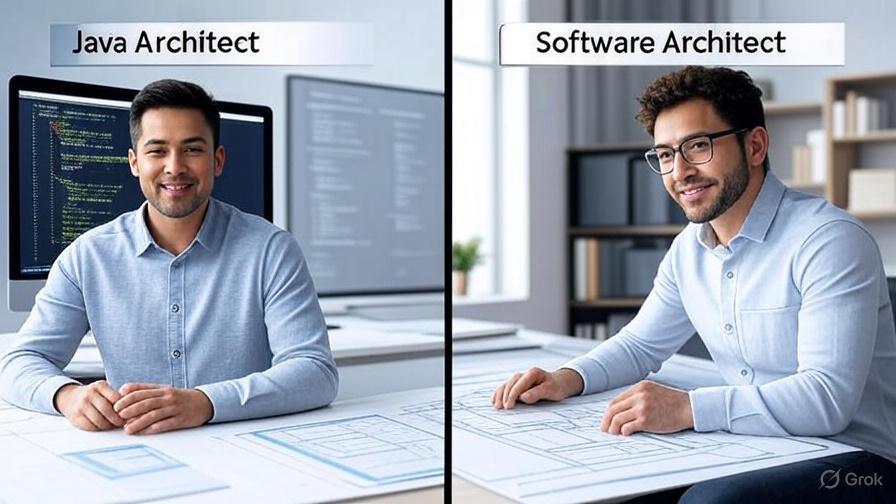Java Architect vs. Software Architect: Key Differences Explained

Introduction
In the realm of software development, the roles of a Java Architect and a Software Architect are often confused. While both positions are crucial in shaping the technological landscape of an organization, they come with distinct responsibilities, skill sets, and career trajectories. Understanding the differences between these roles can help aspiring professionals make informed career choices. For those interested in pursuing a career as a Java Architect, consider enrolling in a comprehensive java architect course to gain the necessary skills and knowledge. Additionally, understanding the java architect roles and responsibilities can provide valuable insights into what the job entails.
Understanding the Roles
Java Architect
A Java Architect is a specialized role focused primarily on the Java platform. These professionals are responsible for designing and implementing Java-based applications and systems. They possess deep expertise in Java technologies and frameworks, enabling them to make strategic decisions regarding the Java platform and supporting infrastructure.
Software Architect
A Software Architect, on the other hand, is a broader role that encompasses the design and implementation of software systems across various technologies and platforms. Software Architects are responsible for the overall structure and behavior of software systems, ensuring that they meet business requirements and technical standards.
Key Differences
Scope of Responsibilities
Java Architect:
-
Focuses on Java-specific technologies and frameworks.
-
Designs and implements Java-based applications and systems.
-
Makes strategic decisions regarding the Java platform and supporting infrastructure.
-
Assists team members with the installation and integration of different software.
Software Architect:
-
Encompasses a wider range of technologies and platforms.
-
Designs and implements software systems that meet business requirements and technical standards.
-
Ensures interoperability between different systems and technologies.
-
Provides ongoing support and guidance to development teams on architectural best practices.
Skill Sets
Java Architect:
-
Deep expertise in Java programming and related technologies.
-
Knowledge of Java frameworks such as Spring, Hibernate, and Struts.
-
Experience with application servers, database engines, cloud computing, and service-oriented architectures.
-
Strong understanding of software development methodologies and best practices.
Software Architect:
-
Broad knowledge of various programming languages and technologies.
-
Experience with system design and architecture.
-
Understanding of software development methodologies and best practices.
-
Strong communication and leadership skills.
Career Trajectories
Java Architect:
-
Typically starts as a Java Developer and progresses to a Java Architect role.
-
May specialize in specific areas such as enterprise applications, web applications, or mobile applications.
-
Can advance to senior positions such as Chief Technology Officer (CTO) or Chief Architect.
Software Architect:
-
May start as a Software Developer and progress to a Software Architect role.
-
Can specialize in specific domains such as enterprise architecture, solution architecture, or technical architecture.
-
Can advance to senior positions such as Chief Technology Officer (CTO) or Chief Architect.
The Importance of Both Roles
Both Java Architects and Software Architects play crucial roles in the software development lifecycle. They are responsible for designing and implementing software systems that meet business requirements and technical standards. Their expertise and leadership are essential for the success of any software development project.
Conclusion
In conclusion, while both Java Architects and Software Architects play crucial roles in software development, they come with distinct responsibilities, skill sets, and career trajectories. Understanding the differences between these roles can help you make an informed decision about which path to pursue. Whether you choose to specialize in Java technologies or broaden your expertise across various platforms, both roles offer rewarding career opportunities in the ever-evolving field of software development. Understanding the nuances of Java Architect vs. Software Architect can guide aspiring professionals in making informed career choices.
FAQs
What is the primary focus of a Java Architect?
A Java Architect primarily focuses on designing and implementing Java-based applications and systems. They possess deep expertise in Java technologies and frameworks, enabling them to make strategic decisions regarding the Java platform and supporting infrastructure.
What are the key responsibilities of a Software Architect?
A Software Architect is responsible for the overall structure and behavior of software systems. They ensure that software systems meet business requirements and technical standards, provide ongoing support and guidance to development teams, and ensure interoperability between different systems and technologies.
How do the skill sets of a Java Architect and a Software Architect differ?
A Java Architect requires deep expertise in Java programming and related technologies, knowledge of Java frameworks, and experience with application servers and cloud computing. A Software Architect, on the other hand, needs a broad knowledge of various programming languages and technologies, experience with system design and architecture, and strong communication and leadership skills.
What career trajectories can a Java Architect and a Software Architect expect?
A Java Architect typically starts as a Java Developer and can advance to senior positions such as Chief Technology Officer (CTO) or Chief Architect. A Software Architect may start as a Software Developer and can specialize in domains such as enterprise architecture, solution architecture, or technical architecture, advancing to senior positions like CTO or Chief Architect.
Why are both Java Architects and Software Architects important in software development?
Both roles are crucial in the software development lifecycle. They design and implement software systems that meet business requirements and technical standards. Their expertise and leadership are essential for the success of any software development project.
Can a Java Architect transition to a Software Architect role?
Yes, a Java Architect can transition to a Software Architect role by broadening their expertise across various technologies and platforms, gaining experience in system design and architecture, and developing strong communication and leadership skills.
What are the typical starting points for a Java Architect and a Software Architect?
A Java Architect typically starts as a Java Developer, while a Software Architect may start as a Software Developer. Both roles require a strong foundation in software development and a deep understanding of programming languages and technologies.
What are the salary expectations for Java Architects and Software Architects?
Salary expectations can vary based on experience, location, and the specific organization. However, both roles are typically well-compensated due to their critical importance in software development and their requirement for specialized skills and expertise.
What certifications are beneficial for aspiring Java Architects and Software Architects?
For Java Architects, certifications such as Oracle Certified Master, Java EE 6 Enterprise Architect, and other Java-specific certifications are beneficial. For Software Architects, certifications like TOGAF (The Open Group Architecture Framework) and Certified Software Architect (CSA) can be valuable.
How do Java Architects and Software Architects contribute to the success of a software development project?
Java Architects and Software Architects contribute to the success of a software development project by designing and implementing robust software systems, ensuring that they meet business requirements and technical standards, providing guidance and support to development teams, and ensuring interoperability between different systems and technologies. Their leadership and expertise are essential for delivering high-quality software solutions.






